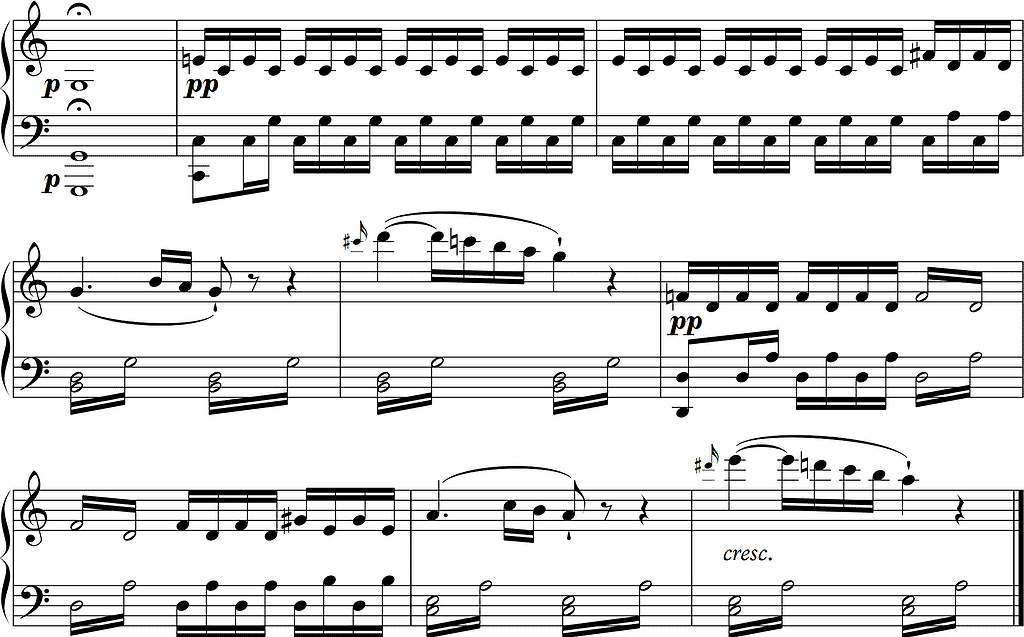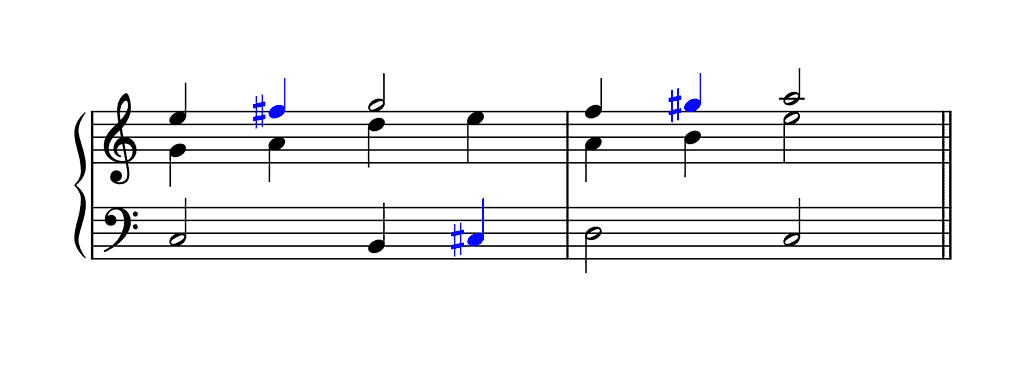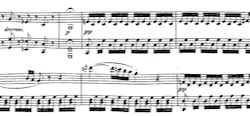In this essay, I will discuss the characteristics of a voice-leading pattern that is a variant of the Leaping Monte Romanesca: the Stepwise Monte Romanesca.
The term Stepwise Monte Romanesca refers to a rising sequential pattern in which each segment consists of a descending step in the bass with each subsequent segment one step higher than the previous one. The first bass note of each segment is usually set as a triad, the second as a sixth chord.
To facilitate the reading of this essay, I use Robert Gjerdingen’s black-circled figures to indicate scale steps in the melody (e.g. ➍–➌) and white-circled figures to indicate scale steps in the bass (e.g. ⑦–①).
Note further that ‘Bar 1a’ refers to the first half of bar 1, ‘bar 1b’ to its second half.
Term and Interpretation
For more information on the term and interpretation of the (Leaping) Monte Romanesca see my essay The Leaping Monte Romanesca.
Mode and Structure
Like a Leaping Monte Romanesca, a Stepwise Monte Romanesca occurs only in major and can have two, two and a half or three segments.
The Bass of a Stepwise Monte Romanesca
Below you can see the bass of a Stepwise Monte Romanesca, which is characterized by a model consisting of a descending step transposed at least once a up step:

Realizing this Bass
This bass is usually set with a triad on the first structural note of each segment and a sixth chord on the second:

The Two-Part Stepwise Monte Romanesca
The shortest type of Stepwise Monte Romanesca consists of two segments, as the previous example shows.
The second bass note may also be chromatically lowered, already announcing the minor quality of the second segment:

The Two-Part Stepwise Monte Romanesca with Tonicization
A Stepwise Monte Romanesca may also contain local-key fragments, where tonicization can occur at the level of a segment or of a bass note.
In the next example, D minor —the start of segment 2– is announced by the c♯ in the bass:

The second structural note of each segment, but not the first of the second segment, can be tonicized by introducing them in the upper part with an f♯2 and g♯2, respectively:

Note the melodic augmented second in the upper part in bar 2a, which composers used in this context.
Beethoven used this variant in the first movement of his Waldstein Sonata:

(Two-Part Stepwise Monte Romanesca: bars 13–20)
All structural notes can of course be tonicized, creating a beautiful imitative setting:

The Two-and-a-Half-Part Stepwise Monte Romanesca
A Stepwise Monte Romanesca can also consist of two and a half segments, with the third segment breaking off after its first structural note:

Arcangelo Corelli, among others, wrote such a type of Stepwise Romanesca:

Allegro, bars 30–37 (Two-and-Half-Part Monte Romanesca: bars 30–34), ed. F. Chrysander (Sonate Da Chiesa A Tre Opera Terza, London: Augener & Co., 1888–91), public domain, available on https://imslp.org
The Three-Part Stepwise Monte Romanesca
If the second structural bass note of the third segment is set with a chromatically raised ➍, the Stepwise Monte Romanesca consists of three segments. The second structural bass note can also be chromatically raised, acting as a temporary leading note:

Below you can see a Three-Part Stepwise Monte Romanesca from a keyboard sonata by Carl Philipp Emanuel Bach:

Note that a two-and-a-half-part and a three-part Stepwise Monte Romanesca can also be tonicized (not shown).
Further Reading (Selection)
Gjerdingen, Robert O. Music in the Galant Style (New York: Oxford University Press, 2007).
Gjerdingen, Robert O. Child Composers in the Old Conservatories — How Orphans Became Elite Musicians (New York: Oxford University Press, 2020).
IJzerman, Job. Harmony, Counterpoint, Partimento: A New Method Inspired by Old Masters (New York: Oxford University Press, 2018).
Rice, John A. Climbing Monte Romanesca: Eighteenth-Century Composers in Search of the Sublime (Unpublished Essay, 2017), https://www.academia.edu/32429345/ (accessed 5 March 2024).
Sanguinetti, Giorgio. The Art of Partimento — History, Theory, and Practice (New York: Oxford University Press, 2012).
